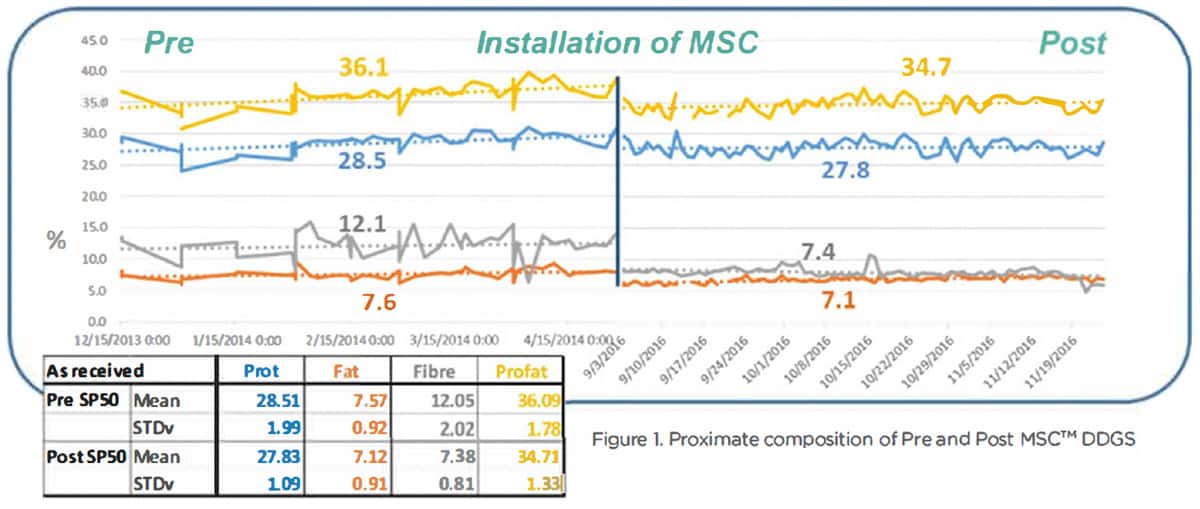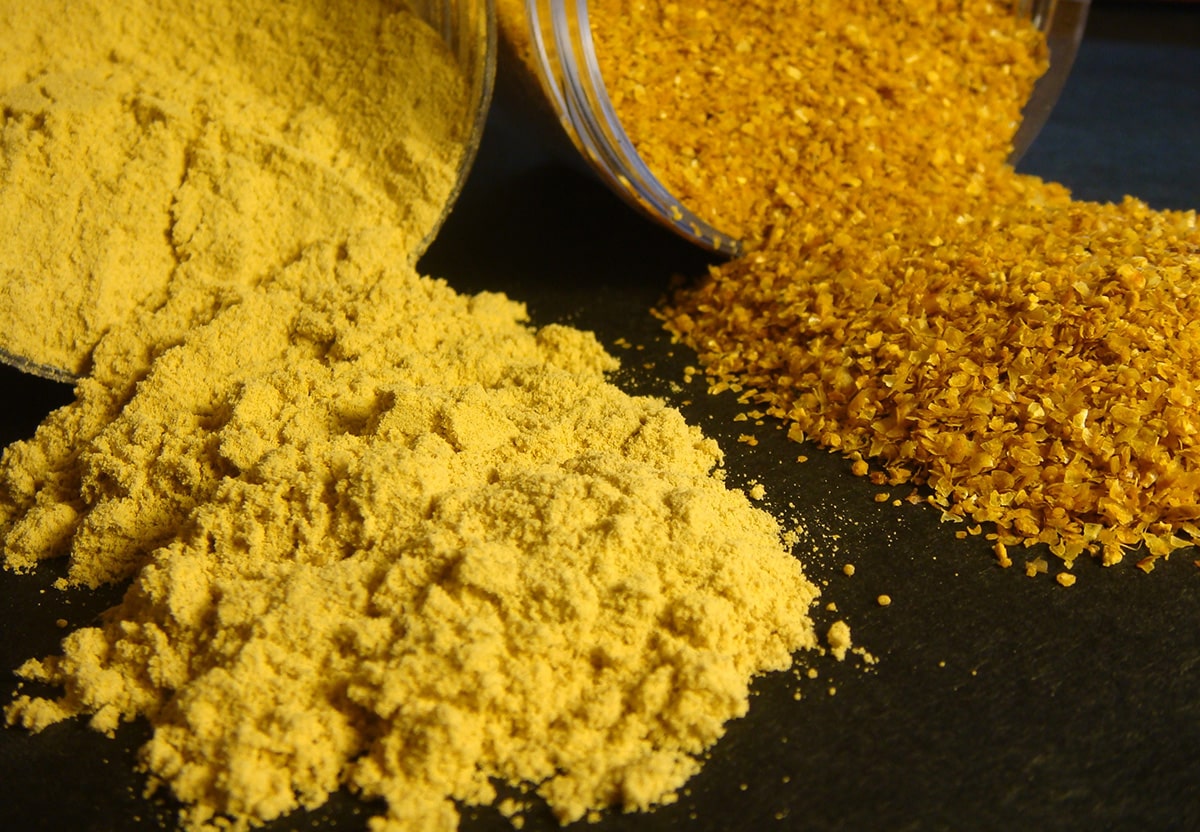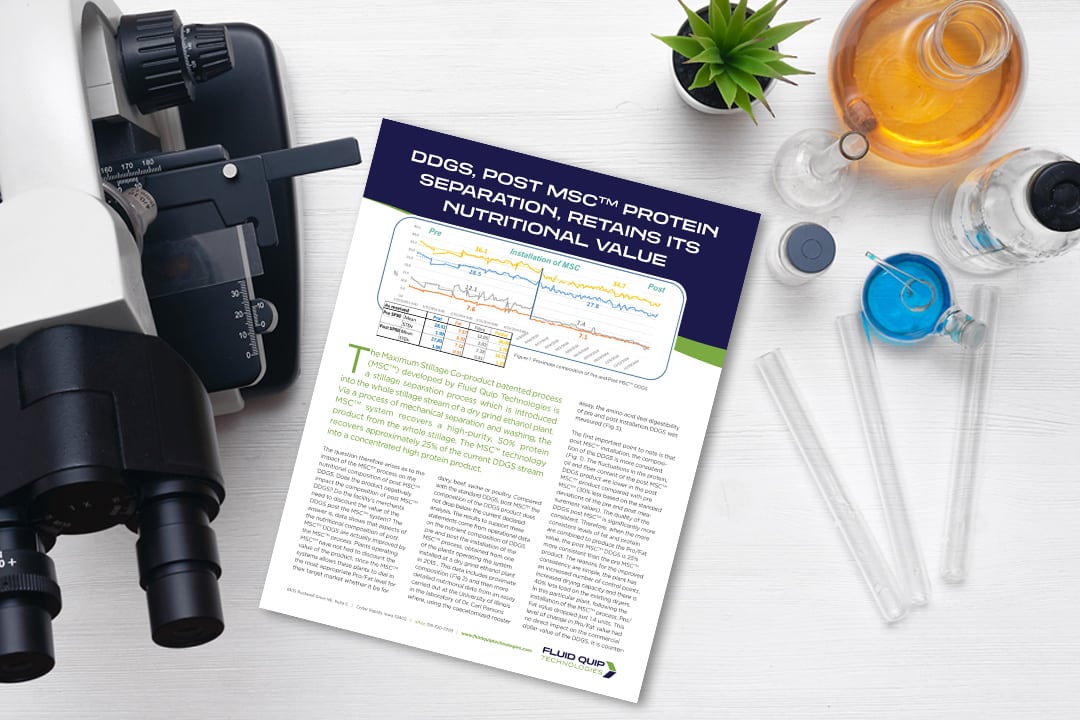DDGS, POST MSC™ PROTEIN SEPARATION, RETAINS ITS NUTRITIONAL VALUE
Maximum Stillage Co-product (MSC™)
The Maximum Stillage Co-product patented process (MSC™) developed by Fluid Quip Technologies is a stillage separation process which is introduced into the whole stillage stream of a dry grind ethanol plant. Via a process of mechanical separation and washing, the MSC system recovers a high-purity, 50% protein product from the whole stillage. The MSC technology recovers approximately 25% of the current DDGS stream into a concentrated high protein product.

The question therefore arises as to the impact of the MSC process on the nutritional composition of post MSC DDGS. Does the product negatively impact the composition of post MSC DDGS? Do the facility’s merchants need to discount the value of the DDGS post the MSC system? The answer is, data shows that aspects of the nutritional composition of post MSC DDGS are actually improved by the MSC process. Plants operating MSC have not had to discount the value of the product, since the MSC systems allows these plants to dial in the most appropriate Pro/Fat level for their target market whether it be for dairy, beef, swine or poultry. Compared with the standard DDGS, post MSC the composition of the DDGS product does not drop below the current declared analysis. The results to support these statements come from operational data on the nutrient composition of DDGS pre and post the installation of the MSC process, obtained from one of the plants operating the system installed at a dry grind ethanol plant in 2015. This data includes proximate composition (Fig 2) and then more detailed nutritional data from an assay carried out at the University of Illinois in the laboratory of Dr. Carl Parsons where, using the caecetomized rooster assay, the amino acid ileal digestibility of pre and post installation DDGS was measured (Fig 3).

The first important point to note is that post MSC installation, the composition of the DDGS is more consistent (Fig. 1). The fluctuations in the protein, oil and fiber content of the post MSC DDGS product are lower in the post MSC product compared with pre MSC (30% less based on the standard deviations of the pre and post measurement values). The quality of the DDGS post MSC is significantly more consistent. Therefore, when the more consistent levels of fat and protein are combined to produce the Pro/Fat value, the post MSC DDGS is 25% more consistent than the pre MSC product. The reasons for the improved consistency are simple, the plant has an increased number of control points, increased drying capacity and there is 40% less load on the existing dryers. In this particular plant, following the installation of the MSC process, Pro/ Fat value dropped just 1.4 units. This level of change in Pro/Fat value had no direct impact on the commercial dollar value of the DDGS. It is counter-intuitive that the Pro/Fat value has not fallen more. The reason lies in the fact the post MSC fiber level in DDGS is also lower, so the non-fibrous components of the post MSC DDGS are more concentrated than pre MSC installation. Since the value of DDGS is based on the concentration of protein and fat and not the absolute quantity, the Pro/Fat value is only minimally affected. This minimal change in DDGS composition flows through into the nutrient value of the product. For monogastrics, swine and poultry, the Total Digestible Nutrient values for pre and post MSC DDGS were 75.8 and 76.0 respectively i.e. no difference in nutrient composition between the two products for monogastrics. Figure 2 shows the energy value for ruminants for maintenance, lactation and gain and again there was no difference between pre and post MSC DDGS values.
Reducing the rotary dryer loading via the installation of the MSC technology also significantly benefits the production of residual DDGS. How DDGS is dried has a significant impact on the overall quality of the product. High heat or extended exposure to heat negatively impacts the quality of the protein, particularly in terms of degrading biological availability. As plants have continued to increase their production capacity, the ability to effectively dry the DDGS product has become more challenging. As in many cases over the past years the wet cake feed rates have increased by more than 40%, one of the fixes has been to raise the operating temperature of the current DDGS dryers. Raising the drying temperature can negatively impact the digestive value of DDGS. The caecetomized rooster assay measures the ileal digestibility of protein and was used to compare the ileal digestibility of amino acids pre and post installation of MSC. The ileal digestibility of all DDGS amino acids (Fig.3) is marginally higher for the post MSC process. The small drop in the ileal digestibility amino acid content is driven by the marginally lower protein content in the post MSC DDGS. Therefore, although the total amino acid content is marginally lower these essential amino acids are marginally more available to the animal.
The first question that the nutritionist asks when confronted with the MSC process is “If I install the MSC™ process what is the net effect on my residual DDGS? If I have to discount the value of my DDGS is there value to install-ing the MSC process?” These results obtained over a two-year period from an operational plant running the MSC process when differences in the composition of the grain used in the plant will have been evened out, show that the answer is very simple and is the converse. There is no need to discount the price of your DDGS; in fact you can claim they are of higher value. They are of even higher value for lactation and beef when the slightly lower protein level increases the opportunity to raise the level of DDGS inclusion in the feed formulation.
The MSC process is currently operating at four ethanol facilities worldwide. It is a bolt on, turnkey process that permits the bioethanol plant to diversify and significantly increase the value of the co-product streams. Furthermore, this operational data shows that this can be achieved while maintaining if not increasing the value per ton of the residual DDGS feed product.
U.S. Patents: 8,778,433, 8,813,973, 9,066,531, 9,963,671, 10,160,932, 10,190,076, 10,233,404, 10,266,790, 10,519,398, 10,800,994, 10,875,889, 10,926,267, 10,995,346, 11,220,663, 11,230,504, 11,427,784 and EP 2410869 and Canada: 2,763,476



